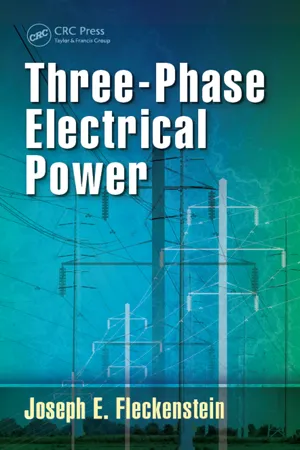
- 413 pages
- English
- ePUB (mobile friendly)
- Available on iOS & Android
Three-Phase Electrical Power
About this book
Three-Phase Electrical Power addresses all aspects of three-phase power circuits. The book treats the transmission of electrical power from the common sources where it is generated to locations where it is consumed. At typical facilities where electrical power is used, the book covers the important topics of grounding, currents, power, demand, metering, circuit protection, motors, motor protection, power factor correction, tariffs, electrical drawings, and relays. Included in the text are the necessary methods of computing currents and power in all possible types of circuit applications as those that are balanced, unbalanced, leading, lagging, three-wire, and four-wire.
Focusing on electrical gear, programs, and issues related to the generation and use of three-phase electrical power, this contemporary educational guide:
- Uses simple, straightforward language to explain key concepts and their underlying theory
- Introduces numerous examples, illustrations, and photographs to aid in comprehension
- Employs phasor concepts throughout the text to aid in the analysis of three-phase circuits
- Encourages applied learning by supplying practical problems at the end of each chapter
- Provides extensive references and a glossary of symbols, acronyms, and equations
Three-Phase Electrical Power delivers a much-needed modern-day treatment of three-phase electrical power for electrical engineering students and practitioners alike.
Frequently asked questions
- Essential is ideal for learners and professionals who enjoy exploring a wide range of subjects. Access the Essential Library with 800,000+ trusted titles and best-sellers across business, personal growth, and the humanities. Includes unlimited reading time and Standard Read Aloud voice.
- Complete: Perfect for advanced learners and researchers needing full, unrestricted access. Unlock 1.4M+ books across hundreds of subjects, including academic and specialized titles. The Complete Plan also includes advanced features like Premium Read Aloud and Research Assistant.
Please note we cannot support devices running on iOS 13 and Android 7 or earlier. Learn more about using the app.
Information
Table of contents
- Cover
- Half Title
- Title Page
- Copyright Page
- Table of Contents
- Preface
- Author
- 1. Alternating Current
- 2. Generation, Transmission, and Distribution
- 3. Grounding
- 4. Calculating Currents in Three-Phase Circuits
- 5. Calculating Three-Phase Power
- 6. Demand and Demand Response
- 7. Instruments and Meters
- 8. Circuit Protection
- 9. Motors and Motor Protection
- 10. Power Factor Correction
- 11. Tariffs
- 12. Relays and Contactors
- 13. Electrical Drawings
- Appendix
- Symbols, Acronyms, and Equations
- References
- Index